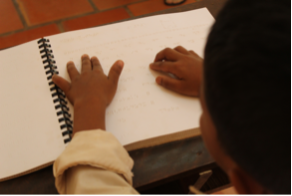MCSIE

Donor: USAID • Partner: Purdue University • Timeframe: Aug. 2019 – Oct. 2024
Multi-Country Study on Inclusive Education (MCSIE)
IDP conducted a five-year evaluation of USAID inclusive education activities in Cambodia, Malawi, and Nepal through the USAID-funded Long-Term Assistance and SErvices for Research Partners for University-Led Solutions Engine (LASER PULSE) by a consortium through the Purdue Applied Research Institute. The Multi-Country Study on Inclusive Education (MCSIE) was the first major effort by USAID to investigate what works to improve the quality of education for learners with disabilities. The activities in Cambodia, Malawi, and Nepal represented USAID’s most concerted effort to date to build systems to ensure learners with disabilities have access to quality education.
Evaluating five thematic areas (process, screening and identification, teacher training, instructional approaches, and unintended consequences), MCSIE derived lessons about what works to sustainably advance teaching and learning outcomes for children with disabilities in varying contexts. The findings from MCSIE will be used by USAID and its partners to inform adaptations to current initiatives and plans for new disability-inclusive education programming. MCSIE has produced a number of deliverables, including country-level and comparative reports, a comprehensive final report, and evaluation guide on measuring disability inclusion within education programming to further advance the global evidence base on disability-inclusive education programming. All publicly available resources are linked below and can be found at USAID’s Education Links (EduLinks) website.
Project Highlights
- Conducted country-specific and comparative (multi-country) literature and policy reviews around the situation of disability-inclusive education.
- Produced detailed evaluation reports identifying strengths and areas of opportunity related to inclusive literacy instruction, screening and identification of children with disabilities, and teacher training in each country.
- Used evaluation methodologies that include key informant interviews and focus group discussions with implementing partners, disabled persons’ organizations, national and subnational government stakeholders, classroom teachers, principals, and parents; household surveys of parents of children with disabilities; secondary source document review and rubric analysis; and training and classroom observations.
- Mapped areas of intervention to include existing systems and actors engaged in disability inclusion within each country.
- Developed an evaluation guide for monitoring, evaluation and learning (MEL) staff and other professionals on how to collect, monitor, and evaluate programming for learners with disabilities across the education continuum using USAID standard and supplemental education indicators.
Project Resources
MCSIE Overview
- LASER PULSE: Purdue University’s partnership with IDP on the MCSIE project
- Evaluation Guide on Measuring Disability-Inclusive Education
- Education Links: MCSIE Comparative Literature Review
- Education Links: Learning from the Multi-Country Study on Inclusive Education
- MCSIE Final Report
Country Reports and Mapping
- Cambodia
- Malawi
- Nepal
Country-Specific MCSIE Pages
Additional Resources
- Lessons from the Multi-Country Study on Inclusive Education
- An Evaluator’s Reflection: Insights from the Multi-Country Study on Inclusive Education (MCSIE)
- MCSIE Findings by Evaluation Questions
- MCSIE: Recommendations for Areas for Future Evaluation
- MCSIE: School-Based Screen System Feedback Loop – 1 pager
- MCSIE: School-Based Screen System Feedback Loop – 2 pager
